The MGA With An Attitude
How Do You ORGANIZE YOUR PARTS? -- CF-100
I knew this was going to be a fun subject right off. First things first, lets start with the BIG stuff. As soon as I had my own home and a garage to work in, the first thing I did was to install electrical wiring and good lights, insulate the place, and put pegboard on the interior walls all around. That was soon followed by a gas space heater with thermostat on the wall. Several years later I bought a different house and promptly built a workshop addition on the garage with similar treatment.
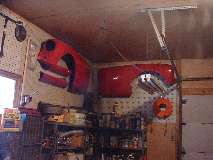
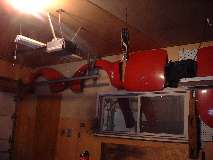
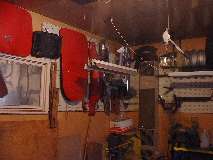
After work space, power, light and heat, the pegboard all around is very handy. As soon as you start taking a car apart you have bonnet and boot lid and fenders and doors all over the place. Add to that rag top frame, battery cover, dash panel, splash panels, bumpers and bumper brackets and other such parts that may be a bit too large to sit on a shelf. The more of this stuff you can hang on the walls the less you have on the floor, and the more floor space you keep clear for work space. Given proper building configuration, you might also have available some loft space or attic access. Use whatever space you may have available, even a basement if you have to, but do try to avoid stowing car parts in the living room.
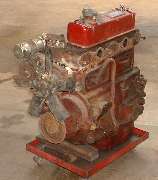
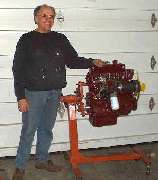 Getting down to things that are only moderately large but may be heavy, you may have an issue of where to store an engine or gearbox or rear axle assembly. When I decided to keep a good inventory of spare parts many years ago, the first obvious solution was to keep large assemblies assembled as much as possible. It is WAY easier to store a complete engine or gearbox than it is to keep track of boxes full of loose parts. Since I drive my MGA a LOT, I will wear out an engine or gearbox "periodically". This means at predictable intervals, and more often than "occasionally". As such I will commonly keep a spare engine and spare gearbox handy. The engine might be left attached to a (cheap and small) roll-around engine stand to be easily moved aside if it gets in the way.
Getting down to things that are only moderately large but may be heavy, you may have an issue of where to store an engine or gearbox or rear axle assembly. When I decided to keep a good inventory of spare parts many years ago, the first obvious solution was to keep large assemblies assembled as much as possible. It is WAY easier to store a complete engine or gearbox than it is to keep track of boxes full of loose parts. Since I drive my MGA a LOT, I will wear out an engine or gearbox "periodically". This means at predictable intervals, and more often than "occasionally". As such I will commonly keep a spare engine and spare gearbox handy. The engine might be left attached to a (cheap and small) roll-around engine stand to be easily moved aside if it gets in the way.
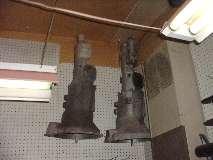 Otherwise the stand is disassembled and stored on a shelf while the engine sits on a small roller platform pushed under the workbench.
Otherwise the stand is disassembled and stored on a shelf while the engine sits on a small roller platform pushed under the workbench.
Gearboxes are a little easier. They weigh less but are still not particularly small. For some reason I often have more than one lying about. I have a couple of saw horses with a piece of plywood that serves an easily portable work bench. This normally resides in one end of the garage, and space underneath it may shelter one gearbox sitting on the floor, a short step ladder and a roll around seat. When I need that floor space or have more than one spare gearbox to deal with, I take to hanging the gearboxes from strong screw hooks in the ceiling in one corner of the shop. Just run a couple loops of wire through the rear mount, long enough to reach an inch past the tail end, and hang it tail end up. Air space occupied is only as large as the face of the bellhousing, and I sometimes have two or three of them hanging on the meat hooks, well above head height and off in a corner out of the way of ceiling lights.
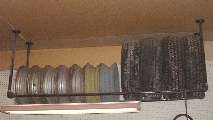 In the mid 90's when I started keeping extra wheels and tires for competition work I built a tire rack to hang from the ceiling. It is made from 20 feet of 3/4" black pipe, 4 elbows, 4 flanges. and a few feet of perforated pipe strap, all very cheap. It is 6 feet long and holds about 10 tires in the 165-195 width range, or half a dozen tires and some bare wheels. Again it's overhead, out of the way, out of mind.
In the mid 90's when I started keeping extra wheels and tires for competition work I built a tire rack to hang from the ceiling. It is made from 20 feet of 3/4" black pipe, 4 elbows, 4 flanges. and a few feet of perforated pipe strap, all very cheap. It is 6 feet long and holds about 10 tires in the 165-195 width range, or half a dozen tires and some bare wheels. Again it's overhead, out of the way, out of mind.
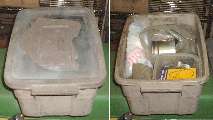 So far so good, and I still have a mostly clear floor. Going down scale we get to parts that are maybe less than a foot long but too large to put in your pocket. This is when I use various sorts of boxes and shelving for three dimensional volume of space. I use shelving that is mostly 12 or 15 inches deep front to back so it doesn't suck up too much floor space, and because most of what I have left to store will easily fit on the relatively narrow shelf. I have a couple of plastic tote boxes about 10x15 inches with flat covers. One holds engine parts while another holds gearbox part, the structural kind of stuff like pistons, con-rods and gears. Slightly larger parts like a cylinder head or crankshaft or empty gear case can sit on a shelf without a package. Since I have (for the most part) only one model of car and car parts in my garage, these larger loose parts do not necessarily need to be tagged with part numbers.
So far so good, and I still have a mostly clear floor. Going down scale we get to parts that are maybe less than a foot long but too large to put in your pocket. This is when I use various sorts of boxes and shelving for three dimensional volume of space. I use shelving that is mostly 12 or 15 inches deep front to back so it doesn't suck up too much floor space, and because most of what I have left to store will easily fit on the relatively narrow shelf. I have a couple of plastic tote boxes about 10x15 inches with flat covers. One holds engine parts while another holds gearbox part, the structural kind of stuff like pistons, con-rods and gears. Slightly larger parts like a cylinder head or crankshaft or empty gear case can sit on a shelf without a package. Since I have (for the most part) only one model of car and car parts in my garage, these larger loose parts do not necessarily need to be tagged with part numbers.
 Going down scale a little more I will have a multitude of small parts that may need to be labeled or bagged, and need to be organized in such a way to be easy to find when needed. In particular, I like to keep on hand one each of every gasket and seal for the whole car, and anything else that may cost less than a dollar. This makes it possible to disassemble and reassemble anything on the car on short notice without having to wait for a parts order. Some parts are moderately large and somewhat fragile, like gaskets for instance. For this I have one hinged-top cardboard box I call "gaskets and seals" large enough to hold a sump gasket laid flat (ditto head gasket and valve cover gasket) and about 6 inches deep. Large gaskets go first flat in the bottom of the box with not much volume used. Then some hoses and fan belt, steering rack gaiters, tail light lenses, and other fist size objects generally too large for a baggie. There is a zip-lock baggie exclusively for wheel hub gaskets and seals, a second baggie for other seals, and a third baggie for other small gaskets. Any part not easily recognizable will have a part number attached or be in a separate envelope within one of these baggies including a part number and/or part description. There is one last larger baggie containing body rubber parts. I'm not sure why I keep that stuff around, as I only have the body apart once every ten years or so for painting. I guess I just hate throwing things out.
Going down scale a little more I will have a multitude of small parts that may need to be labeled or bagged, and need to be organized in such a way to be easy to find when needed. In particular, I like to keep on hand one each of every gasket and seal for the whole car, and anything else that may cost less than a dollar. This makes it possible to disassemble and reassemble anything on the car on short notice without having to wait for a parts order. Some parts are moderately large and somewhat fragile, like gaskets for instance. For this I have one hinged-top cardboard box I call "gaskets and seals" large enough to hold a sump gasket laid flat (ditto head gasket and valve cover gasket) and about 6 inches deep. Large gaskets go first flat in the bottom of the box with not much volume used. Then some hoses and fan belt, steering rack gaiters, tail light lenses, and other fist size objects generally too large for a baggie. There is a zip-lock baggie exclusively for wheel hub gaskets and seals, a second baggie for other seals, and a third baggie for other small gaskets. Any part not easily recognizable will have a part number attached or be in a separate envelope within one of these baggies including a part number and/or part description. There is one last larger baggie containing body rubber parts. I'm not sure why I keep that stuff around, as I only have the body apart once every ten years or so for painting. I guess I just hate throwing things out.
As parts get smaller, now down to pocket size,
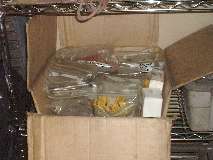 I have another similar size box that works a lot like a filing cabinet. It is filled with two rows of sandwich size zip-lock baggies with write-on labels. I use the Moss Motors catalog and Moss part numbers for inventory records. Each baggie contains parts from one page of the catalog, like Engine Internal, Engine External, Oil System, Cylinder Head, etc, right through the whole catalog, ending with Interior Trim parts. In the end this turns out to be a fairly well stuffed box, but very well organized.
I have another similar size box that works a lot like a filing cabinet. It is filled with two rows of sandwich size zip-lock baggies with write-on labels. I use the Moss Motors catalog and Moss part numbers for inventory records. Each baggie contains parts from one page of the catalog, like Engine Internal, Engine External, Oil System, Cylinder Head, etc, right through the whole catalog, ending with Interior Trim parts. In the end this turns out to be a fairly well stuffed box, but very well organized.
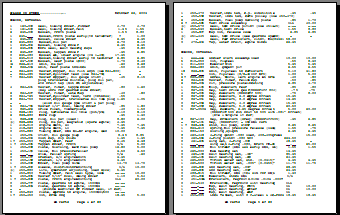 The real key to success in keeping track of all this stuff has to be an inventory list, so I will never run short or end up paying for and storing multiple parts I don't need. Before computers the inventory list was in a card file, one card per part number. Starting in the early 80's, the inventory list became a word processor text file with one line per part number. When I started this list it was three pages long and already a big help in keeping track of parts I had on hand. Today it is more than 36 pages long and includes some books, tools and trailer parts on the tail end, maybe 1200 part numbers or so. I'm sure that many people don't realize just how many spare parts they might have in their possession, much less knowing exactly what they have or don't have and where to find it when needed.
The real key to success in keeping track of all this stuff has to be an inventory list, so I will never run short or end up paying for and storing multiple parts I don't need. Before computers the inventory list was in a card file, one card per part number. Starting in the early 80's, the inventory list became a word processor text file with one line per part number. When I started this list it was three pages long and already a big help in keeping track of parts I had on hand. Today it is more than 36 pages long and includes some books, tools and trailer parts on the tail end, maybe 1200 part numbers or so. I'm sure that many people don't realize just how many spare parts they might have in their possession, much less knowing exactly what they have or don't have and where to find it when needed.
The one critical requirement to make the inventory list work is to keep up with the changes. When I use parts in the shop I write it down or put the numbered envelope in my pocket, then update the list the very next time I touch the computer. When I receive a new parts order the first thing on opening the box is to verify all parts ordered have arrived, then add this stuff to the inventory list. The only exception is when I get new parts and install them on the car immediately, then add any remaining contents of the box to the inventory list. If you neglect the record keeping even a few times, the inventory list would be off in count, which can cause all sorts of consternation. Then you get to do inventory to count everything to get the list back on track. Keeping up the inventory list is a little bit of work, but it saves lots more time by reducing searching for parts and waiting for deliveries.
|